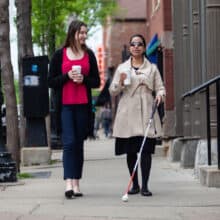Commentary: Is Braille Still Important?
Without a doubt, technology has become an integral part of our daily lives, especially for people with disabilities. New devices make it possible for those of us with physical, visual and other impairments to do things that were previously impossible. Not a month goes by without hearing about new devices or apps that allow people who are blind to access and read print material without needing Braille. Just a few days ago, I came across an article about a new ring-like device that would read out loud books, letters and other print documents. New devices like these make people wonder if Braille is still important.
To me, inquiring if Braille is necessary is like asking if print is still important. For people who are blind, knowing Braille is the equivalent of knowing to read and write print by someone with sight. I began learning Braille during preschool, the same time my sighted classmates were learning print. Braille allows those of us without sight to learn to read and write. What’s most important, it teaches us to spell and to understand the rules of grammar and punctuation. It would be difficult at the very least to learn all of this by simply listening to audio materials.
Braille is important even for adults who already know how to read and write. It has long been known that learning Braille can be a tremendous challenge for older adults. Diseases like diabetes make it difficult to be able to decipher the dots by touch. Not to mention the complex nature of the Braille system, which some describe as similar to learning a new language. Still, people who lose their sight at a later age should learn basic Braille. It will help them with simple things like reading elevator signs and labeling household items.
I am not undermining the importance and helpfulness of today’s assistive technology by any means. Thousands of people with vision loss now have greater access to print books and other documents thanks to new devices and software. I can read important letters in a matter of seconds without having to wait for them to be transcribed into Braille or for someone to read them to me. This is incredibly helpful both at home and on the job. I am sure that new devices like the one I recently read about will continue to allow people who are blind to have more access to the printed word, resulting in greater independence.
Braille will always be an important means of reading and writing for people without sight. Although audio books and screen-reading technology help us have instant access to print materials, nothing can substitute the confidence and independence that reading and writing Braille provides. Both Braille and technology are equally important for people who are blind, and this will always be true no matter the time period we live in.

Sandy Murillo works at The Chicago Lighthouse, an organization serving the blind and visually impaired. She is the author of Sandy’s View, a bi-weekly Lighthouse blog about blindness and low vision. The blog covers topics of interest to those living with blindness and vision impairments. Being a blind journalist and blogger herself, Sandy shares her unique perspective about ways to live and cope with vision loss.





